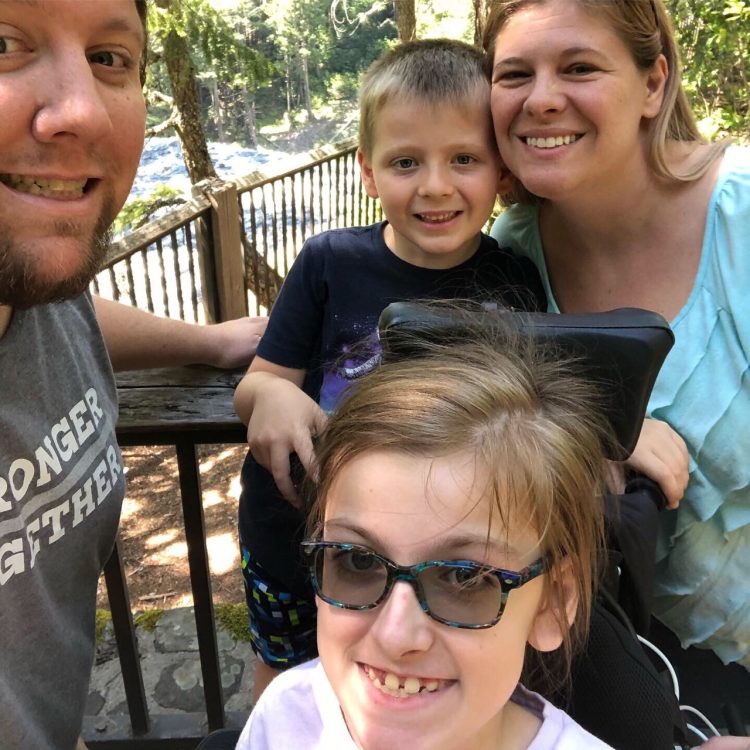Celebrating the Small Wins on My Daughter’s Journey With SMA
This content is sponsored by Biogen and is intended for U.S. Any other present or future content posted by the contributor, not expressly designated as “Biogen sponsored content” is not associated with Biogen.
My 11-year-old daughter Lucy is many things: an artist, a writer, an inventor. She also happens to have spinal muscular atrophy (SMA), a genetic disorder affecting the motor neuron cells in the spinal cord, which are key for muscle development and movement. Like many people who have not been personally affected by SMA, I had no idea what this disorder was until Lucy was diagnosed at 18 months old. Since that day, my husband and I have done everything in our power to help our daughter live the most “normal” and loving life possible. Getting to where we are now has been a learning process for all of us.
In the first year of Lucy’s life, my husband and I went about our days just as any new parents would – excited, exhausted and filled with joy. It wasn’t until Lucy was around 9 months old that her daycare teacher mentioned something seemed off. Lucy wasn’t crawling or trying to stand like the other infants her age. At first, we didn’t feel too worried about it; we were new parents and didn’t know what to expect in terms of baby milestones. However, we started watching her at home and noticed she wasn’t putting a lot of weight on her legs, so we took her to the pediatrician. He told us that everything was fine, but we decided to get a second opinion.
That second opinion landed us in physical therapy (PT), where we were told that Lucy’s symptoms were only an issue with muscle tone. When we stopped PT after a few months, Lucy’s condition drastically declined. We knew then something was seriously wrong and brought her for tests at our local children’s hospital, where doctors finally diagnosed her with Type 2 SMA at 18 months old.
SMA is a rare genetic disease that causes severe, progressive muscle weakness and affects one in every 11,000 live births.1 The most common form of SMA is caused by inheriting a mutated survival motor neuron 1 (SMN1) gene from each parent, of which my husband and I both happen to be carriers. Individuals with SMA do not produce enough motor neuron (SMN) protein, which is critical for the maintenance of motor neurons that support sitting, walking, and feeding.
Lucy’s diagnosis was incredibly challenging for our family, and I still tear up thinking about that time. But as parents, we had to power through and provide Lucy with what she needed to live her fullest life. At the time, there was no treatment for SMA, so this meant years of working with the specialists that we were seeing regularly to find a viable option to help preserve her motor function for as long as possible.
After Lucy’s diagnosis, I joined several SMA groups and heard about SPINRAZA®(nusinersen), the first prescription medication approved to treat children and adults with SMA. Please see full Prescribing Information and Important Safety Information for more information about SPINRAZA. Although it was still in clinical trial phase at the time, I was excited about the future prospect of a treatment for Lucy. So, I reached out to her neurologist expressing our interest in SPINRAZA. When it was approved by the Food and Drug Administration (FDA) in 2016, I was ecstatic. From that point on, I made daily calls to everyone on Lucy’s care team, from her doctors to the insurance carrier. Sometimes, it can be difficult to get a treatment approved by insurance companies, which can require additional testing or documentation. Luckily for me, as a medical billing specialist, I understand the ins and outs of insurance as a part of my job and knew what the process would entail. We knew there were some risks in pursuing SPINRAZA as a treatment option for SMA; Lucy could experience side effects from the medication and from the procedure to receive it, along with increased risk for bleeding and kidney damage. The most common side effects of SPINRAZA include lower respiratory infection, fever, constipation, headache, vomiting, back pain, and post-lumbar puncture syndrome. However, even with these risks, the alternative was much worse for our family – if Lucy’s SMA was untreated, she would continue to lose motor function. So, we persisted. I needed to get this treatment for my daughter, and eventually, I succeeded.
The three years since Lucy started on SPINRAZA have been a journey marked by small wins. Lucy opened a door for the first time. She has been able to push through her legs and lift herself off her seat. By October 2020, Lucy had gone one full year without hospitalization for the first time – a huge milestone for us. Of course, this is just our experience – others may vary.
As Lucy has gotten older and curious about her SMA, we have started talking more openly with her about the side effects surrounding her disease. To accommodate her around the house, we recently installed a smart speaker system and were surprised to hear her asking increasingly tough questions to research SMA. She’s a very intelligent girl who understands the breadth of her disease, even if she keeps her emotions close to the chest sometimes.
My husband and I did not get tested before having Lucy, however, once we got pregnant with my son Lucas, we tested in utero. We confirmed that Lucas is a carrier but does not have SMA.
Growing up, Lucas has always helped care for Lucy and comes up with ways to include her in his playtime without being told. As parents, we know he will have different milestones than Lucy – like tying his shoes or showering on his own – but it feels like Lucas raised himself to be a brother to someone living with SMA. Lucas and Lucy even have a special phrase they created to help in conversations with their friends and kids their age. They just say that Lucy’s muscles don’t work the same as other kids’ muscles; that’s why she needs a wheelchair.
My advice to parents who may find themselves suddenly confronting their child’s SMA diagnosis is to consider all options. As hard as it is to accept, don’t fight recommendations for intervention. It can be hard to say that your child needs help. We fought against it at first, and I only wish we had started sooner for Lucy.
Lucy doesn’t feel stigmatized by her wheelchair; she sees herself as an 11-year-old who likes drawing and art, unicorns and galaxies – someone who gets excited to spend the summer at science camp. For Halloween, I used to think of ways to incorporate her wheelchair into our family costumes. Recently, she told me her wheelchair is just a wheelchair; it doesn’t have to be a costume. As a parent, you can’t ask for more than the opportunity to see your child grow into someone who loves and accepts herself.

INDICATION
SPINRAZA®(nusinersen) is a prescription medicine used to treat spinal muscular atrophy (SMA) in pediatric and adult patients.
IMPORTANT SAFETY INFORMATION
Increased risk of bleeding complications has been observed after administration of some similar medicines. Your healthcare provider should perform blood tests before you start treatment with SPINRAZA and before each dose to monitor for signs of these risks. Seek medical attention if unexpected bleeding occurs.
Increased risk of kidney damage, including potentially fatal acute inflammation of the kidney, has been observed after administration of similar medicines. Your healthcare provider should perform urine testing before you start treatment with SPINRAZA and before each dose to monitor for signs of this risk.
The most common possible side effects of SPINRAZA include lower respiratory infection, fever, constipation, headache, vomiting, back pain, and post-lumbar puncture syndrome.
These are not all the possible side effects of SPINRAZA. Call your healthcare provider for medical advice about side effects. You may report side effects to FDA at 1-800-FDA-1088.
Before taking SPINRAZA, tell your healthcare provider if you are pregnant or plan to become pregnant.
Please see full Prescribing Information.
This information is not intended to replace discussions with your healthcare provider.
References:
- Cure SMA. About SMA. Available at https://www.curesma.org/about-sma/. Accessed: February 2021.
SPZ-US-4066
03/2021


